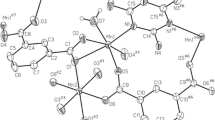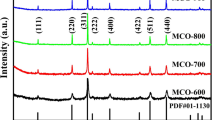Abstract
The electrochemical performances of the α-, γ-, and δ-MnO2 with different crystallographic structures were systematically investigated in 0.5 mol/L Li2SO4, 0.5 mol/L Na2SO4, 1 mol/L Ca(NO3)2, and 1 mol/L Mg(NO3)2 electrolytes. The results showed that the electrochemical performances of the manganese dioxides depended strongly on the crystallographic structures of MnO2 as well as the cation in the electrolytes. Because the δ-MnO2 consists with layers of structure and the interlayer separation is 7 Å, which is suitable for insertion/extraction of some alkaline and alkaline–earth cations, the δ-MnO2 electrode showed the higher specific capacitance than that of α-MnO2 and γ-MnO2. We also found that the α-, γ-, and δ-MnO2 electrodes in the Mg(NO3)2 electrolyte showed a higher specific capacitance, while all the α-, γ-, and δ-MnO2 electrodes in the Li2SO4 electrolyte exhibited a better cycle life. The reason for the different behavior of Li+ and Mg2+ during the charge/discharge process can be ascribed to the charge effect of the cations in the electrolytes. The ex situ X-ray diffraction (XRD) and long-time cyclic voltammogram measurements were used to systematically study the energy storage mechanism of MnO2-based electrodes. A progressive crystallinity loss of the materials is also observed upon potential cycling at the oxidized states. A reasonable charge/discharge mechanism is proposed in this work.









Similar content being viewed by others
Reference
Chen W, Rakhi RB, Hu L, Xie X, Cui Y, Alshareef HN (2011) High-performance nanostructured supercapacitors on a sponge. Nano Lett 11:5165–5172
Pang SC, Wee BH, Chin SF (2011) The capacitive behaviors of manganese dioxide thin-film electrochemical capacitor prototypes. International Journal of Electrochemistry 2011:1–10
Beidaghi M, Wang Z, Gu L, Wang C (2012) Electrostatic spray deposition of graphene nanoplatelets for high-power thin-film supercapacitor electrodes. J Solid State Electrochem 16:3341–3348
Hastak RS, Sivaraman P, Potphode DD, Shashidhara K, Samui AB (2012) High temperature all solid state supercapacitor based on multi-walled carbon nanotubes and poly[2,5 benzimidazole]. J Solid State Electrochem 16:3215–3226
Qu Q, Zhang P, Wang B, Chen Y, Tian S, Wu Y, Holze R (2009) Electrochemical performance of MnO2 nanorods in neutral aqueous electrolytes as a cathode for asymmetric supercapacitors. J Phys Chem C 113:14020–14027
Yuan CZ, Gao B, Shen LF, Yang SD, Hao L, Lu XJ, Zhang F, Zhang LJ, Zhang XG (2010) Hierarchically structured carbon-based composites: design, synthesis and their application in electrochemical capacitors. Nanoscale 3:529–545
Zhai D, Li B, Xu C, Du H, He Y, Wei C, Kang F (2011) A study on charge storage mechanism of α-MnO2 by occupying tunnels with metal cations (Ba2+, K+). J Power Sources 196:7860–7867
Li GR, Feng ZP, Ou YN, Wu D, Fu R, Tong Y-X (2010) Mesoporous MnO2/carbon aerogel composites as promising electrode materials for high-performance supercapacitors. Langmuir 26:2209–2213
Wang Y, Yuan A, Wang X (2008) Pseudocapacitive behaviors of nanostructured manganese dioxide/carbon nanotubes composite electrodes in mild aqueous electrolytes: effects of electrolytes and current collectors. J Solid State Electrochem 12:1101–1107
Beaudrouet E, Salle ALGL, Guyomard D (2009) Nanostructured manganese dioxides: synthesis and properties as supercapacitor electrode materials. Electrochim Acta 54:1240–1248
Devaraj S, Munichandraiah N (2008) Effect of crystallographic structure of MnO2 on its electrochemical capacitance properties. J Phys Chem C 112:4406–4417
Ghodbane O, Pascal JL, Fdr F (2009) Microstructural effects on charge-storage properties in MnO2-based electrochemical supercapacitors. ACS Appl Mater Interfaces 1:1130–1139
Ragupathy P, Park DH, Campet G, Vasan HN, Hwang SJ, Choy J-H, Munichandraiah N (2009) Remarkable capacity retention of nanostructured manganese oxide upon cycling as an electrode material for supercapacitor. J Phys Chem C 113:6303–6309
Chen S, Zhu J, Wu X, Han Q, Wang X (2010) Graphene oxide-MnO2 nanocomposites for supercapacitors. ACS Nano 4:2822–2830
Guo S, Wang F, Chen H, Ren H, Wang R, Pan X (2012) Preparation and performance of polyvinyl alcohol-based activated carbon as electrode material in both aqueous and organic electrolytes. J Solid State Electrochem 16:3355–3362
Kuo SL, Wu NL (2006) Investigation of pseudocapacitive charge-storage reaction of MnO2·nH2O supercapacitors in aqueous electrolytes. J Electrochem Soc 153:A1317–A1324
Wang DW, Li F, Liu M, Lu GQ, Cheng H-M (2008) 3D Aperiodic hierarchical porous graphitic carbon material for high-rate electrochemical capacitive energy storage. Angew Chem 47:373–376
Subramanian V, Zhu H, Vajtai R, Ajayan PM, Wei B (2005) Hydrothermal synthesis and pseudocapacitance properties of MnO2 nanostructures. J Phys Chem B 109:20207–20214
Toupin M, Brousse T, Bélanger D (2002) Influence of microstucture on the charge storage properties of chemically synthesized manganese dioxide. Chem Mater 14:3946–3952
Xie X, Gao L (2007) Characterization of a manganese dioxide/carbon nanotube composite fabricated using an in situ coating method. Carbon 45:2365–2373
Yang X, Yg W, Hm X, Yy X (2007) Interfacial synthesis of porous MnO2 and its application in electrochemical capacitor. Electrochim Acta 53:752–757
Yuan A, Wang X, Wang Y, Hu J (2010) Comparison of nano-MnO2 derived from different manganese sources and influence of active material weight ratio on performance of nano MnO2/activated carbon supercapacitor. Energy Convers Manage 51:2588–2594
Xu C, Du H, Li B, Kang F, Zengc Y (2009) Capacitive behavior and charge storage mechanism of manganese dioxide in aqueous solution containing bivalent cations. J Electrochem Soc 156:A73–A78
Ghaemi M, Ataherian F, Zolfaghari A, Jafari SM (2008) Charge storage mechanism of sonochemically prepared MnO2 as supercapacitor electrode: effects of physisorbed water and proton conduction. Electrochim Acta 53:4607–4614
Pang SC, Chin SF, Ling CY (2011) Controlled synthesis of manganese dioxide nanostructures via a facile hydrothermal route. J Nanomaterials 2012:1–7
Wei W, Cui X, Chen W, Ivey DG (2009) Electrochemical cyclability mechanism for MnO2 electrodes utilized as electrochemical supercapacitors. J Power Sources 186:543–550
Xu C, Kang F, Li B, Du H (2010) Recent process on manganese dioxide supercapacitors. J MaterRes 25:1421–1432
Ghodbane O, Ataherian F, Wu NL, Favier F (2012) In situ crystallographic investigations of charge storage mechanisms in MnO2-based electrochemical capacitors. J Power Sources 206:454–462
Toupin M, Brousse T, Bélanger D (2004) Charge storage mechanism of MnO2 electrode used in aqueous electrochemical capacitor. Chem Mater 16:3184–3190
Xua C, Wei C, Li B, Kang F, Guan Z (2011) Charge storage mechanism of manganese dioxide for capacitor application: effect of the mild electrolytes containing alkaline and alkaline–earth metal cations. J Power Sources 196:7854–7859
Athoul L, Moser F, Dugas R, Crosnier O, Blanger D, Brousse T (2008) Variation of the MnO2 birnessite structure upon charge/discharge in an electrochemical supercapacitor electrode in aqueous Na2SO4 electrolyte. J Phys Chem C 112:7270–7277
Wu MS, Guo ZS, Jow JJ (2010) Highly regulated electrodeposition of needle-like manganese oxide nanofibers on carbon fiber fabric for electrochemical capacitors. J Phys Chem C 114:21861–21867
Xu C, Du H, Li B, Kang F, Zengc Y (2009) Asymmetric activated carbon-manganese dioxide capacitors in mild aqueous electrolytes containing alkaline–earth cations. J Electrochem Soc 156:A435–A441
Li B, Rong G, Xie Y, Huang L, Feng C (2006) Low-temperature synthesis of α-MnO2 hollow urchins and their application in rechargeable Li+ batteries. Inorg Chem 45:6404–6410
Bao SJ, Li CM, Li HL, Luongc JHT (2007) Morphology and electrochemistry of LiMn2O4 optimized by using different Mn-sources. J Power Sources 164:885–889
Gao T, Glerup M, Krumeich F, Nesper R, Fjellvåg H, Norby P (2008) Microstructures and spectroscopic properties of cryptomelane-type manganese dioxide nanofibers. J Phys Chem C 112:13134–13140
Xu M, Kong L, Zhou W, Li H (2007) Hydrothermal synthesis and pseudocapacitance properties of α-MnO2 hollow spheres and hollow urchins. J Phys Chem C 111:19141–19147
Benhaddad L, Makhloufi L, Messaoudi B, Rahmouni K, Takenouti H (2009) Reactivity of nanostructured MnO2 in alkaline medium studied with a micro-cavity electrode: effect of synthesizing temperature. ACS Appl Mater Interfaces 1:424–432
Xu MW, Zhao DD, Bao SJ, Li HL (2007) Mesoporous amorphous MnO2 as electrode material for supercapacitor. J Solid State Electrochem 11:1101–1107
Kanoh H, Tang W, Makita Y, Ooi K (1997) Electrochemical intercalation of alkali-metal ions into birnessite-type manganese oxide in aqueous solution. Langmuir 13:6845–6849
Shannon RD (1976) Revised effective ionic radii and systematic studies of interatomic distances in halides and chalcogenides. Acta Crystallogr A32:751–767
Dean JA (1992) Lange’s handbook of chemistry. McGraw-Hill, New York
Acknowledgments
We acknowledge the financial support from National Natural Science Foundation of China (20963011, 21063014 and 21163021), Natural Science Foundation of Xinjiang (2011211A001), and Open Project Program of Xinjiang Laboratory of Advanced Functional Materials (XJDX0902-2010-09).
Author information
Authors and Affiliations
Corresponding author
Rights and permissions
About this article
Cite this article
Ji, CC., Xu, MW., Bao, SJ. et al. Effect of alkaline and alkaline–earth cations on the supercapacitor performance of MnO2 with various crystallographic structures. J Solid State Electrochem 17, 1357–1368 (2013). https://doi.org/10.1007/s10008-013-2001-y
Received:
Revised:
Accepted:
Published:
Issue Date:
DOI: https://doi.org/10.1007/s10008-013-2001-y




